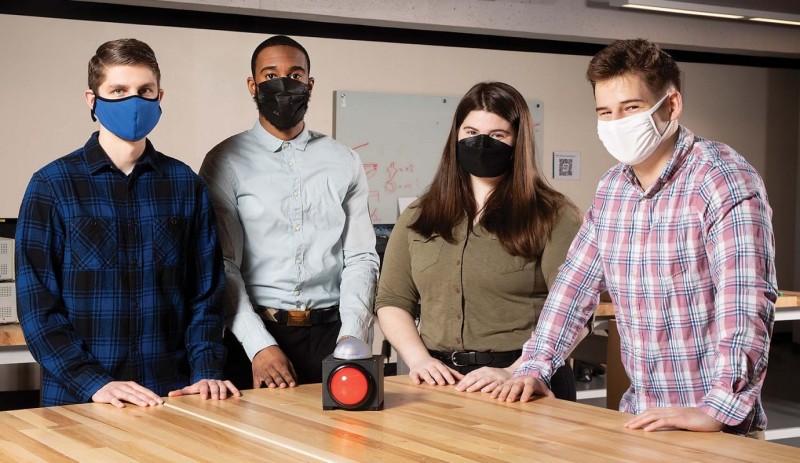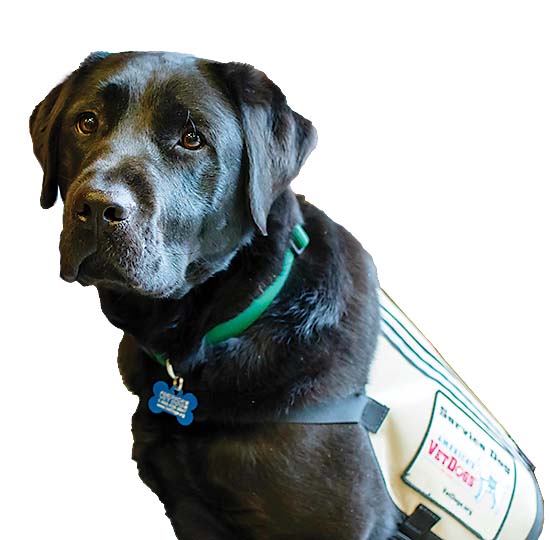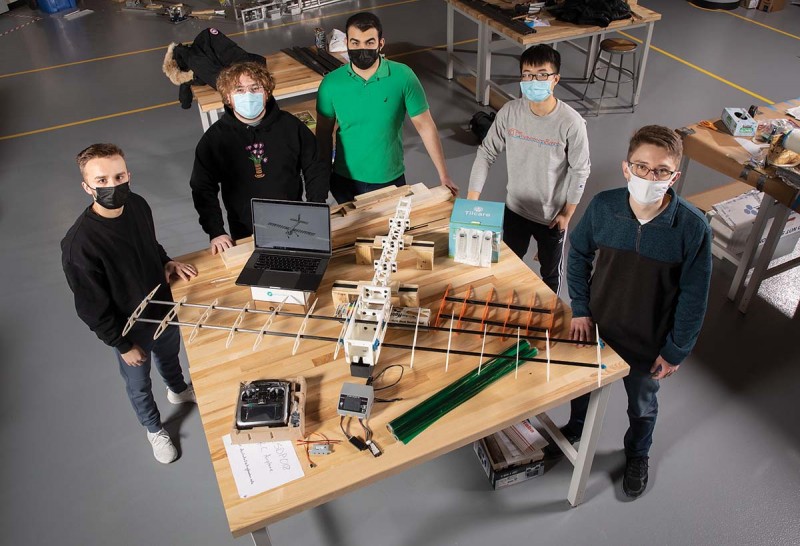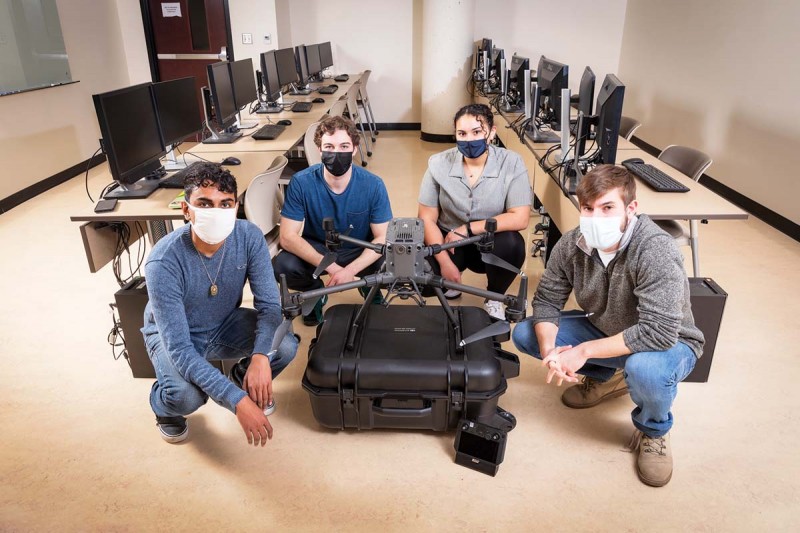Before earning diplomas, many Watson College undergraduates need to complete senior capstone projects addressing real-world challenges. Here are projects from each Watson department this academic year (except computer science, which doesn't have a capstone requirement).
BIOMEDICAL ENGINEERING
Advisor Ammar Abdo (lecturer); students Geena Boasi, Danielle Carucci, Ali Cheema, Vanessa Serna Villa, Amy Tang (all BME), Dylan Macejko (CS)
As common as urinary incontinence is, there aren't many easy-to-use or financially feasible products available for people dealing with the condition to detect when their bladder nears maximum capacity.
"This is an issue we plan to resolve," says Serna Villa, the team leader.
Tasked with developing a bladder sensor that can seamlessly send results via Bluetooth to a mobile device, Serna Villa's team has had the help of recent Watson graduates who attempted the project during the 2020-21 school year.
"The previous team has been very helpful. We've been able to learn from its members' trial and error while building off of their experience," she says.
The sensor the team designed uses electrodes that stick to a patient's abdomen like a Band-Aid. The electrodes are connected to an electrical
component that patients choose to wear on a belt clip or a wrap that goes around their waists.
"It was important that we let the patient decide what option was more comfortable for them," Serna Villa says.
Another key component is making the sensor universally applicable by ensuring the Bluetooth technology is compatible with all popular mobile devices, including iOS and Android.
Serna Villa says her proudest moment came when the team settled on its design: "We sat down for a few hours and went through the process of making those final decisions. And afterward, we were like, 'Wow, we're actually creating this.'"
Most importantly, she's excited about making a product that has the potential to help people.
"We read testimonies from patients who deal with this issue, and it's something that so many people struggle with," she says. "We hope to help them. This project is the very essence of biomedical engineering."
- Allen Wengert
ELECTRICAL AND COMPUTER ENGINEERING
Advisor Meghana Jain (lecturer); students Faith Curtis (electrical engineering), Dillon Kane (computer engineering), Eric Fillingham, Brion Byfield (BME)

Dogs don't need hands to lend a hand. Sometimes, a nose will suffice.
This student group wanted to help a Binghamton-area military veteran by creating a light-control device that a service dog could operate. The dog would use its nose to turn the light on when sensing its owner was having a PTSD-induced dream.
"Our client requested that this light control device be able to produce a few different colors and intensities of light, be portable, have two light-activation modes and be able to utilize wall or battery power," Kane says.
Dogs aren't always a soft touch, so the light had to be durable enough that it wouldn't be damaged or moved by a quick-acting canine. A lampshade was out of play for this reason. What resulted is a small - less than 100 cubic inches - rectangular prism with a push-button for the dog on one side and a toggle switch for the human on the other. The top of the prism has a cover so the light isn't as harsh when looking directly at it.

Kane says the biggest challenge his group faced wasn't related to design or obtaining parts; it was the limited contact he and his peers had with their client.
"Because she has PTSD, we wanted to respect her space and not overwhelm her with crowded Zoom meetings," he says. "We only had communication with her through one of our industry mentors. We were afraid having two levels of communication would cause significant delays, but once the communication method was set up, things went very smoothly."
The project was sponsored by BAE Systems' Tech Power: Innovating for Impact program, which pairs engineering students with employee mentors to design technology solutions for the veteran community.
During the fall semester, the group built a prototype that should be very close to the final design. Winter recess was used for more research into materials and further design refinement.
"We look forward to presenting the prototype to our client to get feedback and seeing how well the device works when the service dog interacts with it," Kane says.
- Steve Seepersaud
MECHANICAL ENGINEERING
Advisors Kirill Zaychik (lecturer), Assistant Professor Pu Zhang; students Ilan Bregman, Daniel Coladangelo, Marwan Gomaa, Brian Lineback (senior ME), Baiyina Richardson (junior ME), Xiaofei Li (junior EE)

While some senior projects allow students to let their imaginations run wild, others require that very specific criteria be met. Team leader Daniel Coladangelo says the specifics have allowed his team project to take off.
"The biggest challenge is often where to get started, but it can be easier to make decisions when you have constraints," he says. "You're able to design around those constraints rather than coming up with your own."
Coladangelo's team is tasked with designing and building an unmanned radio-controlled (RC) airplane that can deliver vaccine components, working under the strict guidelines for the American Institute of Aeronautics and Astronautics (AIAA) 26th annual Design, Build, Fly competition.
The rules require that a third of the team's members are not seniors, which is why two juniors were recruited. Another requirement limits the plane's takeoff distance to only 25 feet.
While Coladangelo didn't have previous experience with RC planes, the amount of 3D printing involved with building the aircraft is what got him interested in this challenge. He says the team's concept went through many changes during the design process.
"The design we initially went with was too heavy and too big," he says. "To get the plane to take off within 25 feet, it needs to be as light as possible. Reducing weight has been one of the toughest challenges."
For advice, the group has consulted with the Binghamton Aeros, a local club of RC enthusiasts. They've also turned to the electrical engineering major on the team, Xiaofei Li, to
help build the electrical circuits needed for the plane.
Coladangelo says the senior project has been a rewarding experience. "It's the culmination of everything we've done for four years," he says. "It brings together all of the skills we've learned to achieve an end goal."
- Allen Wengert
SYSTEMS SCIENCE AND INDUSTRIAL ENGINEERING
Advisors Assistant Professor Yong Wang and Assistant Professor Soongeol Kwon; students Daniel Fee, William Florio, Jenna-Marie Gaston, Rajesh Persad (all SSIE)

The SSIE project focuses on designing a drone inspection system for solar-energy equipment using software to remotely inspect the quality of solar panels using thermal imaging.
The team created a Python-based machinelearning model that accurately predicts the health of a solar panel in real time. A drone attached with a color and thermal camera flies over solar panels, takes videos and uses machine-learning algorithms to analyze the images and identify which solar panels need repair.
The SSIE team hopes to produce a fully automated system that will assist independent and commercial energy producers with the solar-panel maintenance process.
By the end of fall 2021, the team successfully created a preliminary machine-learning model and tested it on existing images of solar panels to identify their condition.
"Since the project is heavily focused on coding, there was a bit of a learning curve before we got the ball rolling," Fee says. "As industrial and systems engineering majors, we don't have courses that dive into the algorithms and topics covered in this project. However, we've all managed to work together effectively and make significant progress."
Despite the challenging coding involved, which was not previously included in their coursework, the SSIE team was able to work together to master Python. In the spring, they created a working system to test on different solar panels.
"As a sustainability engineering minor, I am enjoying contributing to the use and improvement of a renewable energy source," Gaston says. "As we're seeing with an increased change in climate, the use of solar panels will only become more prevalent, so I really enjoyed working with my team in creating this foundation."
- Laura DeLuca '21










